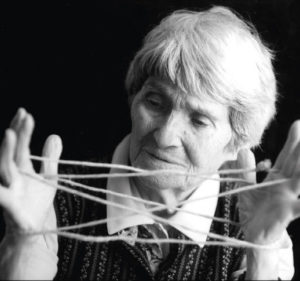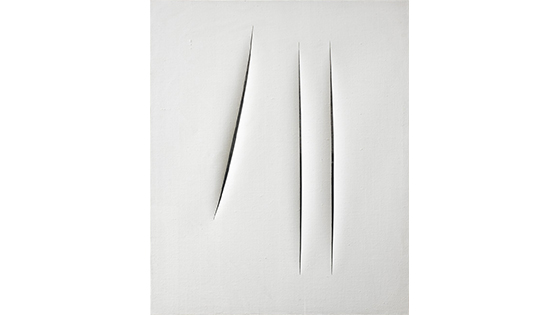La Galleria Christian Stein presenta un’esposizione personale di Giulio Paolini (Genova, 1940) dal titolo Qui dove sono, riferimento a un’opera in mostra e omaggio alla Galleria Christian Stein, dove Paolini espose per la prima volta oltre cinquant’anni fa, nel 1967, presso la sede di Torino e poi, regolarmente, per tutta la sua carriera, fino all’ultima esposizione nel 2016.
La mostra alla Galleria di Corso Monforte si articola in cinque opere di cui tre realizzate espressamente per l’occasione.
Nell’opera, collocata a centro sala, In volo (Icaro e Ganimede) (2019-2020), il calco in gesso di Ganimede, copia di una scultura in marmo di Benvenuto Cellini (1500-71), è collocato su una alta base. Il giovane trattiene due ali di cartoncino dorato ad evocare il suo volo verso l’Olimpo, il mito di Ganimede si fonda infatti sulla bellezza del giovane di cui Zeus, il re degli dèi, si invaghì, questi lo rapì camuffandosi da aquila e lo condusse sull’Olimpo dove ne fece il suo amato. Al suolo una lastra quadrata trasparente lascia intravedere frammenti di un’immagine fotografica del cielo unitamente alla riproduzione della figura di Icaro tratta dal dipinto Dedalus et Icarus (1799) del pittore francese Charles Paul Landon (1761-1826), inoltre un antico mappamondo è posato sulla lastra di plexiglas a ridosso della base. Sia Ganimede che Icaro sono figure mitologiche legate all’atto del volo, Ganimede ascende verso l’Olimpo, mentre Icaro precipita in mare per essersi troppo avvicinato al sole che ne fonde la cera delle ali. Paolini dichiara a proposito delle due figure: “Due corpi nudi, l’uno precipitato al suolo, l’altro proteso verso l’alto, sono entrambi sospesi nella vertigine del volo (del vuoto). Sono attori volti a impersonare i destini paralleli di due personaggi: Icaro e Ganimede, fine e principio di una idea di Bellezza, di una stessa figura senza nome”.
Sulla parete di fondo Vis-à-vis (Kore), 2020 è composta da due metà del medesimo calco in gesso di una testa ellenistica femminile, una Kore, collocate una di fronte all’altra su due basi addossate ad una tela di grandi dimensioni che reca un disegno in prospettiva tracciato a matita. La tela funge dunque da “quinta teatrale”, da spazio scenico che ospita lo sguardo muto dei due volti. Eco di un modello assente e di un’immagine distante, mitica, il calco in gesso costituisce per Paolini uno strumento privilegiato, afferma infatti l’artista: “lo sguardo fissato in un quadro o in una scultura non si rivolge né all’autore né ad altri, non ammette né uno né molti punti di vista, riflette in sé la domanda sulla sua stessa presenza”.
Le pareti di destra ospitano una serie di collage dal titolo Qui dove sono (2019) che rimanda al luogo di residenza dell’artista, Piazza Vittorio Veneto a Torino, storica piazza porticata di forma rettangolare. La serie presenta varie prospettive tracciate a matita, sovrapposizioni e mise en abyme di immagini di diversa origine quali una riproduzione fotografica dell’atrio di ingresso dell’abitazione dell’artista, di un’antica stampa della Piazza o ancora una foto notturna dello stesso luogo. Alcuni collage presentano una figura di spalle intenta a osservare la Piazza (controfigura dell’artista stesso?), altre esibiscono una finestra prospettica nel punto di fuga. La Piazza diviene dunque il teatro ideale per inscenare rimandi di sguardi, inganni percettivi non privi di un’aura metafisica debitrice delle Piazze d’Italia di Giorgio de Chirico, non a caso evocato da figure presenti in due dei collage esposti.
Infine, tra la parete e la finestra, è collocata l’opera Passatempo (1992-98): su una base sono disposti innumerevoli frammenti di vetro, un ritratto fotografico dell’artista e alcuni frammenti di riproduzioni a colori di motivi astrali; in corrispondenza degli occhiali nel ritratto è posata una clessidra. In Passatempo l’autore guarda attraverso il tempo nel tentativo di cogliere ciò che il suo sguardo e la sua mano non possono rinunciare a inseguire. Frammenti di tempo (il ritratto del 1971), indizi di una dimensione assoluta (l’iconografia astrale), uniti alla clessidra (immobile), suggeriscono il desiderio dell’artista di trattenere l’istante ideale in cui potrebbe affiorare una visione compiuta.
Il progetto rappresenta uno dei due episodi espositivi che vedono Paolini impegnato a Milano nel corso del 2020; infatti la mostra di Giulio Paolini, Qui dove sono, alla galleria Christian Stein era inizialmente prevista ad aprile 2020, in concomitanza con Giulio Paolini. Il mondo nuovo, ospitata negli spazi milanesi di Palazzo Belgioioso alla galleria Massimo De Carlo. Inoltre, a partire dal 15 ottobre 2020 e fino al 31 gennaio 2021 il Castello di Rivoli ospita mostra di Giulio Paolini, Le chef-d’oeuvre inconnu, in occasione del suo ottantesimo anniversario.
Giulio Paolini, Qui dove sono
fino al 16 gennaio 2021
Tel. +39 0276393301
LUN-VEN | MON-FRI 10-19 SAB | SAT 10-13 | 15-19
Galleria Christian Stein, Corso Monforte 23, Milano















